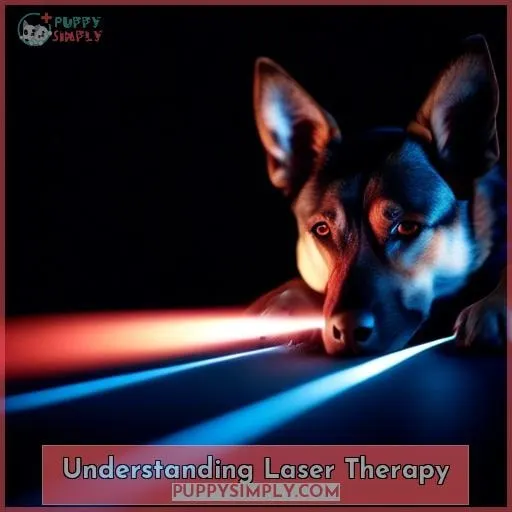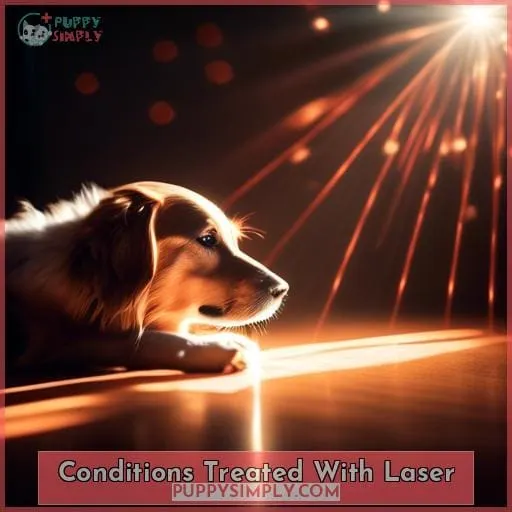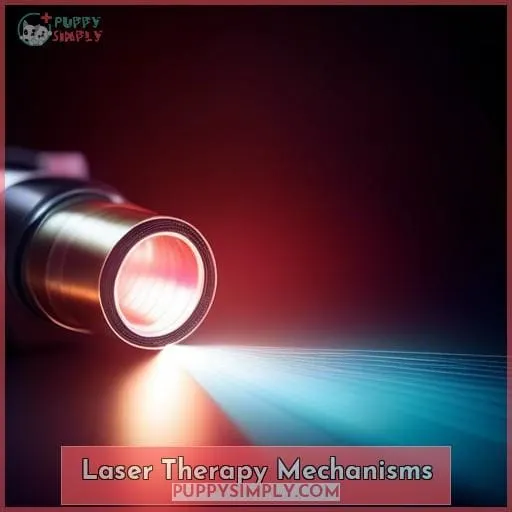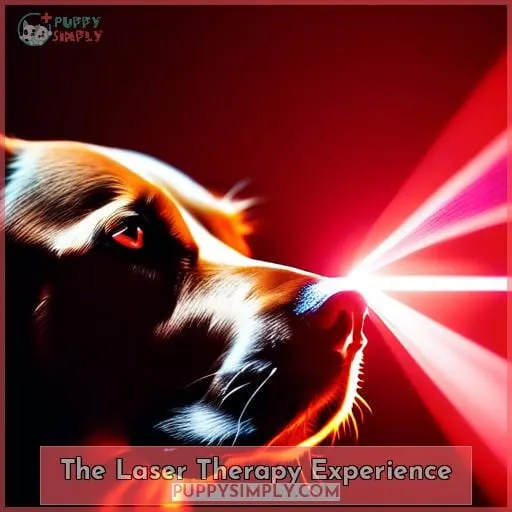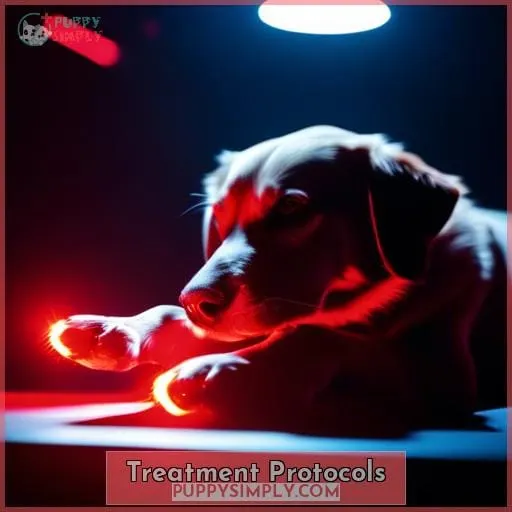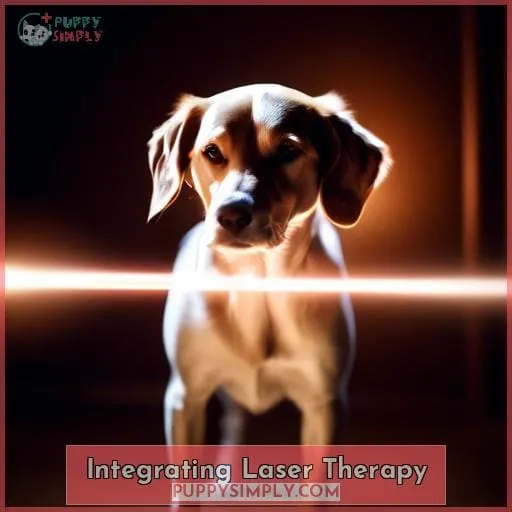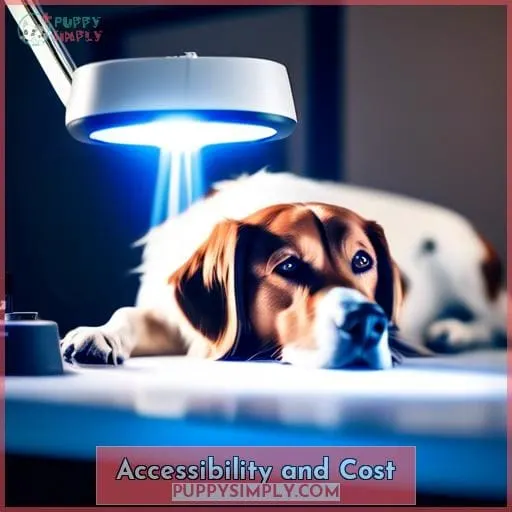This site is supported by our readers. We may earn a commission, at no cost to you, if you purchase through links.
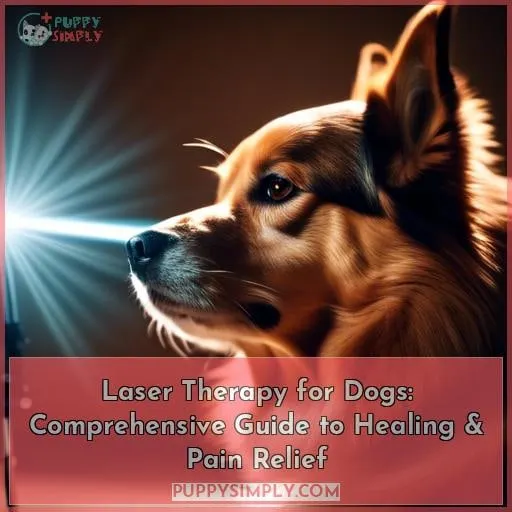 Just like a beacon in the night guides lost ships to safety, laser therapy offers a ray of hope for dogs suffering from various conditions.
Just like a beacon in the night guides lost ships to safety, laser therapy offers a ray of hope for dogs suffering from various conditions.
You’re about to dive into a world where light not only illuminates but heals.
From easing the pain of arthritis to speeding up wound recovery, laser therapy is a non-invasive path to relief and healing for your furry friend.
This guide will walk you through everything from the science behind the technology to real-life success stories, ensuring you and your dog embark on a journey towards better health and comfort.
Table Of Contents
- Key Takeaways
- Understanding Laser Therapy
- Conditions Treated With Laser
- Laser Therapy Mechanisms
- The Laser Therapy Experience
- Session Duration and Frequency
- Treatment Protocols
- Safety and Side Effects
- Integrating Laser Therapy
- Accessibility and Cost
- Research and Effectiveness
- Frequently Asked Questions (FAQs)
- Can laser therapy be used as a preventive measure for conditions that my dog is predisposed to due to its breed?
- Are there any long-term studies on the effects of repeated laser therapy sessions on dogs’ overall health and longevity?
- How does laser therapy compare to traditional pain management methods in terms of cost-effectiveness over a dog’s lifetime?
- Can laser therapy be used in conjunction with dietary changes or supplements to enhance the treatment’s effectiveness for certain conditions?
- Is there a difference in the response to laser therapy between different dog breeds or sizes, and how is the treatment adjusted accordingly?
- Conclusion
Key Takeaways
- Laser therapy is a non-invasive treatment that utilizes light to stimulate cellular function, promoting healing and pain relief in dogs for various conditions such as osteoarthritis, wound healing, and skin and ear infections.
- Safety measures, including the use of protective eyewear for both the dog and staff, are crucial during laser therapy sessions to prevent potential side effects like thermal burns.
- The effectiveness of laser therapy in dogs has been observed in clinical settings, showing significant reductions in pain and improvement in conditions like osteoarthritis, with minimal side effects reported.
- Veterinary professionals must be properly trained in laser therapy techniques and adhere to safety standards to ensure the well-being of the dog and maximize the therapeutic benefits of the treatment.
Understanding Laser Therapy
Laser therapy for dogs harnesses the power of light to heal and relieve pain, offering a non-invasive solution to various conditions.
As you explore this treatment for your furry friend, you’ll learn how specific wavelengths of light can stimulate cells to promote recovery and reduce discomfort.
This guide will walk you through the basics of laser technology and the process of photobiomodulation, ensuring you understand how this innovative therapy can benefit your dog.
Basics of Laser Technology
Your dog’s laser therapy session harnesses the power of light to promote healing and pain relief in a noninvasive way.
- Laser Safety: Ensuring the safe use of lasers during therapy sessions is paramount. Veterinary practices must have protocols in place and may appoint a Veterinary Medical Laser Safety Officer to comply with safety standards.
- Wavelength Selection: The effectiveness of laser therapy for dogs depends on the correct selection of wavelength, which influences how deeply the light penetrates tissue and the type of cellular responses elicited.
- Treatment Duration: The length of each session and the overall treatment period are tailored to your dog’s specific condition, with adjustments made based on the response to therapy.
Photobiomodulation Explained
At the heart of laser therapy for your dog lies photobiomodulation, a process that harnesses light to fundamentally alter cellular function and health. This technique is pivotal in veterinary laser therapy, offering pain relief and tissue healing through precise cellular responses.
| Aspect | Detail |
|---|---|
| Cellular Responses | Stimulates healing |
| Treatment Variations | Tailored to condition |
| Therapeutic Applications | Pain relief, tissue repair |
| Clinical Considerations | Safety, dosage |
Conditions Treated With Laser
Laser therapy offers a non-invasive solution to manage your dog’s health issues, including osteoarthritis and joint pain, wound and injury healing, as well as skin and ear infections.
It’s a versatile treatment that can significantly improve your pet’s quality of life by reducing pain and accelerating recovery.
Let’s explore how this innovative therapy can address these common conditions in dogs.
Osteoarthritis and Joint Pain
How can laser therapy alleviate the chronic pain and mobility issues your dog may be experiencing due to osteoarthritis?
- Arthritis Relief: Targets inflammation, providing pain relief and enhancing joint function.
- Healing Joints: Stimulates cellular repair for improved canine mobility.
- Pain Management: Offers a non-pharmaceutical option to manage discomfort effectively.
Wound and Injury Healing
Laser therapy offers a promising solution for dogs suffering from wounds and injuries, harnessing the power of light to accelerate the healing process and reduce discomfort. This form of treatment, known as photobiomodulation, involves the application of specific wavelengths of light to stimulate cellular responses and tissue regeneration.
Studies have shown that laser therapy can improve the cosmetic appearance of surgical wounds and hasten injury recovery, making it a valuable tool in veterinary applications. The process not only aids in wound healing but also provides pain relief, often resulting in a more comfortable and quicker return to normal activities for your canine companion.
With its ability to reduce inflammation and promote cellular repair, laser therapy for dogs is increasingly recognized as an effective method for managing various types of wounds, including surgical incisions and traumatic injuries.
Skin and Ear Infections
Following the discussion on the healing of wounds and injuries, you’ll find that laser therapy also offers significant benefits for skin and ear infections in dogs.
It reduces inflammation, eases pain, and accelerates healing, enhancing your pet’s comfort and recovery.
Laser Therapy Mechanisms
As you explore laser therapy for your dog, it’s essential to understand how it works at the cellular level to alleviate pain and reduce inflammation.
The laser light stimulates your dog’s cells, enhancing their function and promoting healing.
This process, known as photobiomodulation, is a cornerstone of laser therapy’s effectiveness in managing various canine conditions.
Cellular Level Changes
Transitioning from discussing the various conditions treatable by laser therapy, it’s crucial to delve into how this innovative treatment induces cellular level changes. You’ll find that laser therapy’s magic lies in its ability to stimulate your dog’s cells in a way that promotes healing and reduces pain.
- Cellular regeneration enhances tissue rejuvenation and nerve regeneration.
- Molecular response triggers biochemical changes for trauma wound healing.
- Intracellular signaling aids in reducing scar tissue and pain trigger points.
- Biochemical changes support overall wellness by improving laser therapy for dogs’ pain.
Pain and Inflammation Reduction
Alleviation of discomfort and swelling through laser therapy mechanisms offers a transformative approach to managing your dog’s health. This holistic method enhances traditional pain management techniques, promoting physiological responses at the cellular level.
Red-light therapy specifically targets inflammation reduction, providing long-term benefits to your dog’s quality of life.
Therapeutic applications in veterinary care integrate laser therapy for dogs as a pivotal treatment option.
The Laser Therapy Experience
Before diving into the specifics of laser therapy for dogs, it’s essential to understand what to expect throughout the entire process, from pre-treatment assessments to post-treatment outcomes.
If you’re considering laser therapy for your furry friend, you’ll start with a thorough evaluation to ensure it’s the right option for your pet’s specific needs.
During the session, your dog will experience a non-invasive, pain-free treatment that aims to alleviate discomfort and promote healing.
Afterward, you can look forward to observing improvements in your dog’s condition, with the extent of benefits varying based on the individual case and treatment plan.
This guide will walk you through each step, ensuring you’re well-informed and prepared for what lies ahead in your dog’s laser therapy journey.
Pre-Treatment Assessments
Before you get started with laser therapy for your dog, you’ll need to have them undergo a thorough evaluation.
This assessment will guide treatment planning and evaluate patient suitability. It will also establish follow-up protocols.
During the Session
During your dog’s laser therapy session, you’ll notice the veterinarian or technician carefully moving a handheld laser wand over the affected areas of your pet’s body, delivering therapeutic light that penetrates the skin to promote healing and pain relief.
- Comfort measures ensure your pet’s relaxation
- Eye protection safeguards everyone in the room
- Treatment duration is quick, focusing on recovery
- Pet positioning aids in effective therapy
Post-Treatment Expectations
You’ll likely notice an improvement in your dog’s mobility and pain levels shortly after their laser therapy session.
Recovery timeline varies, but follow-up care, including activity restrictions and monitoring progress, is crucial to prevent potential complications like infection or healing lick granuloma.
Session Duration and Frequency
When considering laser therapy for your dog, it’s important to understand that the duration and frequency of sessions can vary based on the condition being treated.
Acute issues may require shorter, more frequent treatments, while chronic conditions often need ongoing sessions to maintain benefits.
Class 3 and Class 4 lasers differ in intensity and penetration, influencing how long and how often your dog will need therapy.
Acute Vs. Chronic Conditions
When managing your dog’s health, it’s crucial to understand that acute and chronic conditions require different approaches in terms of laser therapy session duration and frequency. Acute conditions often see significant improvement with just a few sessions, while chronic issues may necessitate a more extended treatment schedule, initially more frequent and then tapering to maintenance sessions as improvement is observed.
- Treatment approaches vary; acute injuries might need daily sessions initially, while chronic conditions like arthritis benefit from a steady, spaced-out schedule.
- Patient response is key; observing how your dog reacts to therapy helps tailor the frequency and intensity of sessions, whether it’s a class III or class IV laser.
- Therapeutic outcomes for conditions like anal gland infections, ear infections, or gingivitis can significantly improve with targeted laser therapy, enhancing your pet’s quality of life.
- Clinical considerations and prognostic factors influence the treatment plan, including the type of laser used and the specific health issue being addressed, ensuring the best possible care for your furry friend.
Class 3 and Class 4 Lasers
Considering the differences in power and application, you’re likely to find that Class 3 lasers, with their 1 to 500 mW range, are often referred to as ‘cold’ lasers suitable for therapeutic use. Class 4 lasers exceed 500 mW and are known as ‘hot’ lasers, used for more intensive treatments.
When it comes to laser safety, Class 4 lasers require stringent control measures due to their higher power, which can pose a fire hazard and eye danger. In the realm of veterinary guidelines, these classifications help establish treatment standards, ensuring therapeutic efficacy while prioritizing patient safety.
Clinical applications of both laser types are vast, but it’s crucial to adhere to the recommended session duration and frequency to avoid potential risks and maximize benefits.
Treatment Protocols
When embarking on laser therapy for your dog, it’s crucial to understand the treatment protocols that will guide their recovery journey.
Initially, your dog will undergo an intensive phase of treatment, focusing on reducing inflammation and encouraging cell regeneration.
This phase is followed by ongoing maintenance to sustain the improvements achieved, ensuring your furry friend continues to enjoy a better quality of life.
Initial Intensive Phase
Several treatments may be necessary during the initial intensive phase of laser therapy, aiming to significantly reduce pain and inflammation in your dog’s affected tissues.
After the initial assessment, a tailored treatment plan is crafted.
You’ll be educated on what to expect and how to support your pet.
Follow-up care and progress monitoring are crucial to ensure the best outcome for your furry friend.
Ongoing Maintenance
Following the initial intensive phase of laser therapy for your dog, you’ll transition into the ongoing maintenance phase, during which treatments are spaced out to sustain the healing benefits achieved.
- Maintenance protocols involve regular follow-up sessions to ensure long-term care.
- Preventative treatment may be integrated to avert potential setbacks.
- Sustained benefits are monitored, adjusting the regimen as your dog’s condition evolves.
Safety and Side Effects
When considering laser therapy for your dog, it’s crucial to understand the safety measures and potential risks involved. Protective eyewear is essential for both your pet and anyone present during the session to prevent retinal damage from the laser.
While laser therapy is generally safe and side effects are rare, incorrect use can lead to thermal burns or superficial burns. Therefore, it’s important to ensure that the therapy is administered by a trained professional who follows the correct protocols to maximize benefits while minimizing risks.
Protective Measures
While many treatments for dogs can carry significant risks, laser therapy stands out as a non-invasive option with a plethora of safety measures in place to protect both the pet and the staff during sessions.
You’ll need to ensure that everyone in the room, including your dog, wears protective goggles to shield eyes from the laser’s coherent light, which can cause permanent retinal damage if misdirected.
Potential Risks
Despite the numerous protective measures in place, laser therapy for dogs isn’t without its potential risks, and you’ll need to be aware of these before starting treatment.
Burn risks and tissue damage, including thermal injuries, can occur if the device is improperly used.
That’s why proper training for the operator and eye protection for all present are crucial to ensure safety.
Integrating Laser Therapy
Integrating laser therapy into your dog’s treatment plan can offer a complementary approach to conventional pain management strategies.
It’s a safe, non-invasive option that works alongside other treatments to enhance your pet’s recovery and comfort.
By incorporating laser therapy, you’re providing a multimodal approach to pain relief and healing, ensuring your dog gets the best possible care.
Multimodal Pain Management
Integrating laser therapy into your dog’s pain management plan offers a non-pharmacological option alongside traditional treatments, enhancing overall effectiveness and comfort.
- Efficacy Comparison: Laser often rivals medication in managing pain, with fewer side effects.
- Cost-Effectiveness Analysis: While upfront costs are higher, laser therapy may reduce long-term medication expenses.
- Patient Comfort: Lasers provide pain relief without discomfort, improving your dog’s quality of life.
- Long-Term Outcomes: Multimodal approaches, including laser, often yield better, sustained results.
Complementary to Conventional Treatments
Laser therapy’s integration into your dog’s treatment plan complements conventional treatments, offering a non-invasive, pain-free option to enhance recovery and manage pain effectively.
| Conventional Medicine | Laser Therapy |
|---|---|
| Medications | Non-invasive |
| Surgery | Pain-free |
| Physical Therapy | Enhances Recovery |
| Clinical Outcomes | Evidence-Based Practice |
| Therapeutic Alliance | Treatment Integration |
Accessibility and Cost
When considering laser therapy for your dog, it’s essential to weigh the investment in equipment and the necessary veterinary training against the potential benefits for your pet’s health.
The cost of laser therapy can vary widely, with factors such as the type of laser used, the severity of your dog’s condition, and the location of the clinic influencing the price.
While the upfront costs may seem daunting, the long-term relief and improved quality of life for your dog can be invaluable.
Equipment and Veterinary Training
As we’ve seen, integrating laser therapy into veterinary practice not only enhances treatment options but also necessitates a significant investment in both equipment and training.
- Equipment maintenance ensures longevity and reliability.
- Certification requirements uphold standards of care.
- Hands-on training provides practical experience.
- Safety protocols protect patients and staff, while continuing education keeps practitioners at the forefront of veterinary care advancements.
Cost Factors for Owners
Beyond the initial investment in laser therapy equipment, as a dog owner, you’ll need to consider the ongoing costs of treatments for your pet. Affordability analysis is crucial as single sessions may range from $79 to $300.
Financial considerations should include the frequency of treatments, which can vary based on your dog’s condition—acute issues may require daily sessions, while chronic conditions might need weekly care.
Budget planning is essential, especially since a full course may span several weeks.
Inquire about payment options, as some veterinary practices offer packages or payment plans.
Lastly, consider the economic impact and potential savings from reduced medication needs and improved quality of life for your furry friend.
Research and Effectiveness
When considering laser therapy for your dog, it’s crucial to understand the research and effectiveness behind this treatment.
Current studies, testimonials, and case studies provide a wealth of information on how laser therapy can benefit dogs with various conditions.
By examining these sources, you’ll gain insights into how this non-invasive therapy could improve your pet’s quality of life, especially for those suffering from ailments like osteoarthritis or recovering from surgery.
Current Studies
Transitioning from the topic of accessibility and cost, research into the effectiveness of laser therapy for dogs is crucial for understanding its value in veterinary medicine.
You’ll find that ongoing studies are increasingly highlighting the potential benefits and applications of this treatment modality.
Clinical applications are expanding, with efficacy evaluations and comparative analyses fostering novel protocols.
These studies also focus on long-term outcomes, ensuring a comprehensive understanding of laser therapy’s impact.
Testimonials and Case Studies
Numerous testimonials and case studies have demonstrated the effectiveness of laser therapy in improving the health and well-being of dogs. Owner testimonials and veterinary endorsements often highlight the positive impact on pet recovery stories, with many noting significant improvements in mobility and a reduction in pain.
Home therapy experiences allow owners to actively participate in their pets’ healing process, often leading to enhanced client satisfaction feedback.
- Owner Testimonials: Pet owners report their dogs enjoying a better quality of life, with decreased pain and increased activity levels.
- Veterinary Endorsements: Veterinarians observe improved patient outcomes when laser therapy is integrated into treatment plans, especially with the convenience of home therapy options.
- Pet Recovery Stories: Case studies show successful treatment of various conditions, from arthritis to wound healing, with pets often requiring less medication post-treatment.
Frequently Asked Questions (FAQs)
Can laser therapy be used as a preventive measure for conditions that my dog is predisposed to due to its breed?
Yes, laser therapy can be used as a preventive measure for conditions your dog may be predisposed to due to its breed.
It’s particularly helpful in managing conditions like osteoarthritis by reducing inflammation and pain, even before severe symptoms appear.
This proactive approach can improve your dog’s quality of life by maintaining joint mobility and reducing the need for more invasive treatments later on.
Are there any long-term studies on the effects of repeated laser therapy sessions on dogs’ overall health and longevity?
Long-term studies on the effects of repeated laser therapy sessions on dogs’ health and longevity are limited.
Available research suggests benefits like improved mobility and quality of life.
How does laser therapy compare to traditional pain management methods in terms of cost-effectiveness over a dog’s lifetime?
Laser therapy can be more cost-effective over a dog’s lifetime compared to traditional pain management methods.
While initial equipment costs are high, laser therapy sessions range from $25 to $
This can potentially reduce the need for expensive surgeries or long-term medication.
Can laser therapy be used in conjunction with dietary changes or supplements to enhance the treatment’s effectiveness for certain conditions?
Yes, laser therapy can be combined with dietary changes or supplements to enhance treatment effectiveness for conditions like osteoarthritis.
Integrating nutrition and targeted supplements can support cellular health and optimize the healing process, offering a holistic approach to your pet’s care.
Is there a difference in the response to laser therapy between different dog breeds or sizes, and how is the treatment adjusted accordingly?
Laser therapy’s effectiveness can vary by dog breed and size. This requires adjustments in power, wavelength, and duration to ensure optimal photon delivery and therapeutic effect.
Conclusion
As the sun sets on our exploration of laser therapy for dogs, envision your beloved pet basking in the glow of improved health.
This beacon of healing offers you a non-invasive route to alleviate their pain and accelerate recovery.
Embrace the journey with laser therapy, and you’ll find a harmonious blend of science and comfort, guiding your furry companion to brighter days.

